Something strange happened over the summer in a restaurant in Galway. It made chef Jess Murphy and her kitchen crew wonder if they were listed in some under-the-radar guidebook. Every evening, roughly five of their customers in Kai Restaurant were vegans. Luckily, half of the 22 kitchen staff at Kai are vegetarians. So they had some tricks up their sleeves for a vegan summer.
“We made chocolate desserts out of tofu, used organic dates for a caramel, made vegan ice-cream and our sorbets are all vegan. We used more nutritional yeast and tamari. We all got bored of tofu and started using tempeh. But yeah, it was celeriac steaks and all that kind of stuff.”
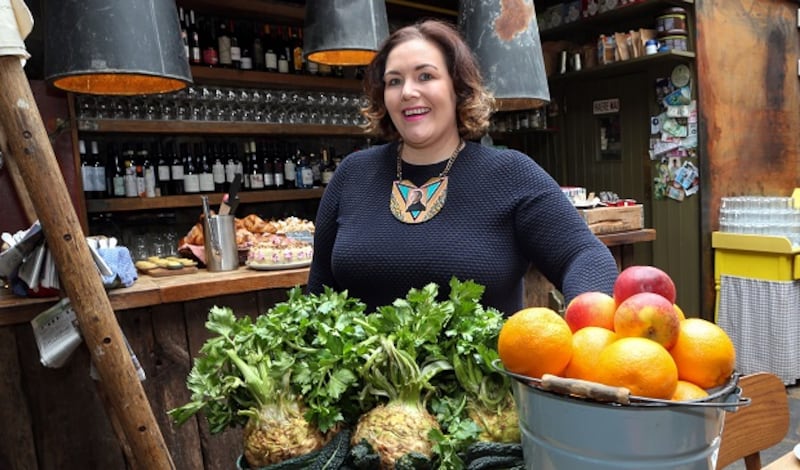
Murphy says she loves vegans, which is still an unusual attitude for a chef. Although that love has limits which end at a carton of nut milk. “Let’s get one thing straight,” Murphy says, “water and nuts isn’t milk. It’s water and nuts. Milk is milk. Milk comes from mammals. Milk doesn’t come from nuts.”
The chef is a former vegan. She cut out dairy, eggs and any other animal products for a brief and supremely unhealthy spell during the nine years when she and her husband David were vegetarians. “We went vegan for three months and I was probably the world’s fattest vegan for those three months.” Working long hours in a restaurant, she didn’t have the time to soak and simmer dried beans so her diet consisted mainly of “going for chips, white bread and bags of crisps.”
It was a time when vegan and vegetarian choices were grim. Her sister-in-law once asked for a veggie burger in a chipper in Carlow. “They handed her a burger bun with iceberg lettuce in it and a couple of slices of tomato.” Another memorable eating low was a “baked bean lasagne”.
Being vegan in Ireland where beef and dairy are our largest industries has long been dismissed as a crank sport, a barely noticeable blip on the chart. But we’ve come a long way in a short time. You no longer have to go into a health food shop smelling of patchouli oil to find oat and almond milk.
Tesco and Dunnes stock vegan cheese and the discounters can supply the ingredients for your soya lattes. The UK Vegan Society gives a slightly creepy thumbs up to Aldi’s “bacon rasher crisps”. And Guinness went vegan this year when brewers phased out the practice of using isinglass, dried fish bladders, to filter out yeast. If the black stuff is preparing for a more vegan future then there must be something in the water.
Deeper roots
Veganism is a Marmite subject. It could be a byproduct of the social media age of vehemence, but the strong feelings feel like they have deeper roots. “I can’t stand vegans,” a friend sighed recently. My pescatarian son (who eats fish but not meat) started pushing his sausages to one side of his plate over a year ago because he felt “sorry for the animals”. It’s a sympathy level that still allows for a bit of magical thinking around gelatin in marshmallows “disappearing” when they’re roasted over fire, but it’s heartfelt nonetheless.
He and his vegetarian friends are part of a new, a la carte, wave, rejecting meat entirely or eating a flexitarian combination of veggie, vegan and omnivore. With meatless Mondays stretching into tofu Tuesday, veganism has broken out of its hemp-lined “just for nutjobs” box, and is coming at you 40 shades of vegan style. Centennials (the new buzz word for anyone born post-1997) might eat vegan Monday to Friday and then pig out at weekends.
There’s a gaggle of vegan apps to direct us to restaurants and cafes, and (inevitably) mountains of stuff to buy. In a few clicks you can discuss the ethics of beeswax, order a pair of vegan Doc Martens (yes, really) and debate the idea of vegetables grown in soil entirely free of animal manure (hydroponics or a future farm on Mars maybe?). Vegans and vegetarians are more visible and vocal now than ever before. If we are what we eat then some of us are becoming what we don’t eat.
The word vegan was coined 63 years ago on a sunny November Sunday in a London club when Donald Watson, a South Yorkshire man born in 1910, met like-minded friends. Watson had been a vegetarian for 20 years. As a child he’d been horrified to witness his uncle George killing a pig on the family farm.
“I suppose at that point I decided that farms, and uncles, had to be re-assessed,” he joked in an interview at the ripe old age of 92. In the 1940s, Watson had been disturbed enough by the animal welfare aspects of dairying (the separation and slaughter of calves) to decide to exclude dairy from his diet. At that meeting in 1944 they tried to find a jazzier name to describe non-dairy eating vegetarianism. Dairybans, neovegetarians, or benevores were some of the options on the list which Watson later described as “very bizarre suggestions”. They settled on his word “vegan” which he insisted be pronounced with a long vee and with a hard “g”.
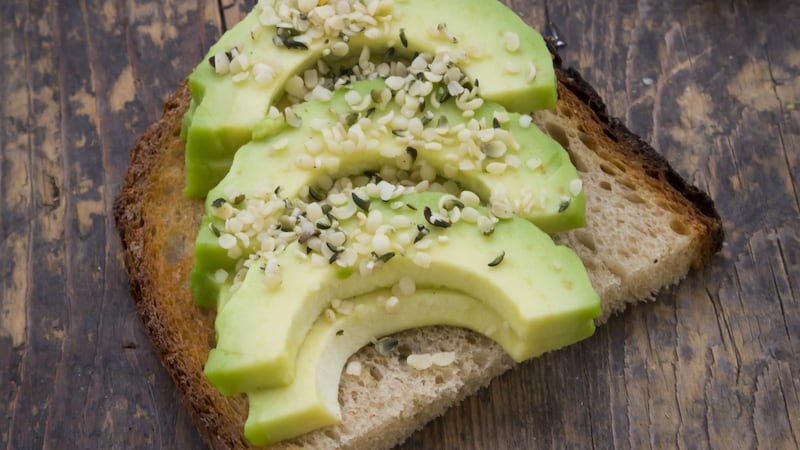
Since those postwar days of earnest efforts to make the world a kinder place, the food system has marched down ever-more intensive farming alleyways. Animal lovers have a lot more to be upset about than they did in Watson’s time, when most animals were reared in places recognisable as farms, rather than the feedlots, battery chicken and pork sheds, fish cages teeming with sea lice and mega dairies of industrial farm landscapes.
There is a growing argument that Big Ag is wreaking havoc on a par with Big Oil. Last week the US advocacy group, Institute for Agriculture and Trade Policy, and non-profit development agency Grain put meat companies in the league of polluters on a vast scale. They calculated that three meat titans, Brazilian JBS, and US firms Cargill and Tyson “emitted more greenhouse gases last year than all of France and nearly as much as some of the biggest oil companies like Exxon, BP and Shell.”
Throw in biodiversity loss, in what environmentalist George Monbiot recently called “insectaggedon”, reducing animal protein in our diet begins to look like a sane response. If centennials are going to be the protest generation, then the food system will be front and centre in their sights.
Meat-eating trends
In our data-steeped existence it’s surprisingly difficult to get statistics on vegetarianism and veganism in Ireland. Figures are as watery and opaque as oat milk. A study earlier this year of just over 1,000 Irish consumers carried out for Bord Bia found that two per cent said they followed a “mainly vegetarian diet”, double the rate in the UK of just one per cent.
The best baseline number to track Irish meat-eating trends is the Central Statistics Office figure on meat consumption. It’s a broadbrush estimate of how much meat is consumed by every man, woman, child and infant in a year, based on the carcass weight of animals divided by the total population. It doesn’t factor in tourist numbers (who presumably account for a fair chunk of full Irish breakfasts and steaks) and the extra weight of bones and offal not actually eaten. So it’s probably an over-estimation. But it’s a useful lump of fact to contrast with Instagram posts of avocado toast.
Between 2001 and 2011, meat consumption per head in Ireland fell from 93kg a year to 77.5kg. So far, so on-trend with the avocado eaters. The CSO stopped recording the figure in 2011 but with some help from a statistician we were able to extract a comparable figure for last year. By 2016 our meat consumption had climbed back up to 90kg a year.
According to Bord Bia figures the biggest jump has been poultry, with consumption up 9 per cent last year. The Irish decline in meat-eating seems to have been as much about economics as ethics. The dip years coincide with the worst years of the crash. The poorer we got the less meat we consumed. If the boom is back so too are the burger and the chicken fillet roll.
As the price of avocados increased, the market grew from a modest €5.6 million a year . . . to almost €18 million
Yet we are also consuming more veggie and vegan stuff. Figures from Kantar Worldpanel show a big jump in two veggie staples in the last five years. In 2013 we were buying 8.3 million packs of avocados a year. By last month annual sales had virtually doubled to 16.5 million. As the price of avocados increased, the market grew from a modest €5.6 million a year five years ago to almost €18 million. Five years ago, we bought 8.6 million packs of plant-based milks. In the year to last month, supermarkets, discounters, grocers and health food shops covered by Kantar sold 14.2 million packs of plant-based milks. It may still be a drop in the ocean compared with animal milk but CSO figures show consumption of drinking milk and buttermilk in Ireland fell from 154 litres a year in 2001 to 135 litres a decade later.
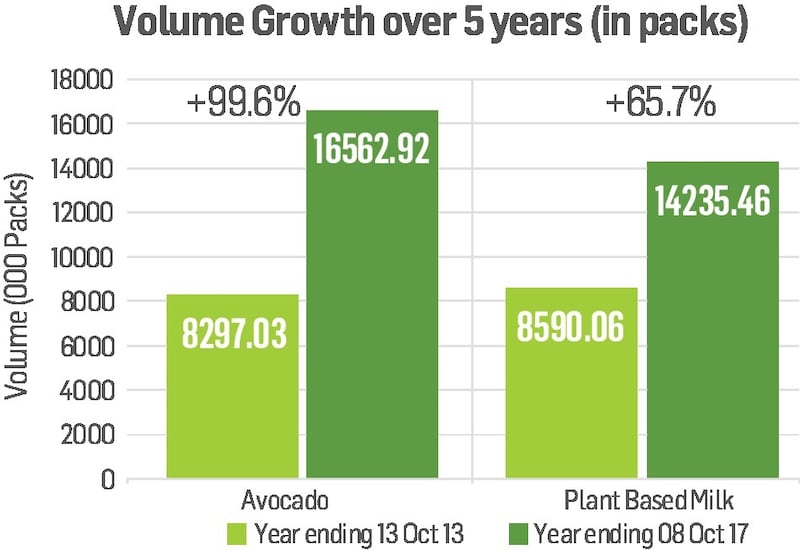
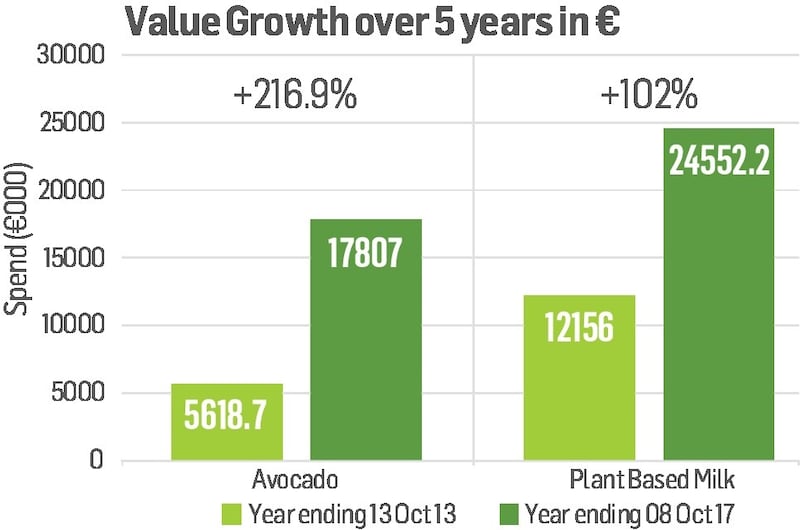
Trendy veg and vegan sales may be rising, but the overall sales of fresh vegetables fell slightly in the last three years. The latest Kantar Worldpanel figures given to Bord Bia show we bought four tonnes fewer fresh vegetables in the year to September compared with 2015. We bought more fruit, 24 tonnes of it, but despite all the chefs’ talk about vegetables going centre stage mass consumption of fresh vegetables fell slightly.
We may not all be going vegan but significant numbers are buying vegan. On World Vegan Day on November 1st, the UK Vegan Society released results of an online survey of more than 2,000 adults carried out over five days in October. “More than half of UK adults are now adopting vegan buying behaviours and Britain is more vegan-friendly that ever before,” it said in a press release. “Around half those surveyed (51 per cent) said they welcomed the rise in vegan foods ... half of those surveyed said they know someone who is vegan and a fifth said they would consider becoming a vegan themselves.”
Bronwyn Slater runs The Irish Vegan website. She started it five years ago as a database of vegan-friendly restaurants around the country. The Cork woman became a vegetarian in her 30s when she was working with an animal charity. "I just said 'Yerra you can't be rescuing dogs and cats and then going home and digging into a big steak.'" She became a vegan eight years ago, partly because of the growing convenience and availability of meat alternatives.
Vegan ready-meals
“It’s so easy now to go vegan,” she says. There are vegan alternatives to every meat. The manufacturers of Quorn, which contains eggs, now have a vegan line. The days of steeping and simmering pulses have dwindled with vegan ready-meals, now available in freezer aisles of mainstream supermarkets.
“You do feel a bit of a lone voice,” Slater says. “But veganism is growing,” she believes. “One way to see it is just to look at the number of products on the shelves. I’d love to get some statistics on it.” The nearest thing to any figure is around 6,000 Dublin members of various vegan Facebook groups.
So who’s buying all this vegan cheese and soya milk? Could it be a wave of consumers putting tofu on the fridge shelf beside the sausages. What does Slater make of that idea of part-time vegans? “Why would you do that?” she asks genuinely bewildered by the idea. There is, in her world, no such thing as being a little bit vegan.
Does she think there’s a danger that people with eating disorders will gravitate towards the clean-eating vegan-y lifestyle? “There’s always going to be people who want to lose weight and use veganism but the lifestyle was created out of a sense of ethics,” she says. In her view if your veganism doesn’t inform all consumption from footwear to face cream you are not a dyed in the wool (or hemp) vegan.
But how ethical are the substitutes that people are using? Can soya milk coming from soya grown in former Amazonian rainforest be a better alternative to local grass-fed milk? What about the Mexican farmers clearing mature pine forests to plant chemical-soaked avocado groves, the working conditions of migrant workers in the palm oil industry, or the chained macaque monkeys used to harvest coconuts for “guilt-free” coconut oil?
“Ninety per cent of the soya grown on those plantations is fed to animals,” Slater says. “It’s unfair to blame vegans for the devastation of the rain forest when most of the soya goes as animal feed.”
But in a globalised food system nothing is simple.
Back in Dublin, chef Mark Senn has just been to the wholesale market for his fennel and a cement-sized bag of puy lentils. He’s doing a Greek-themed evening in his Veginity food truck, parked in a warehouse in a back lane off South Richmond St.
A vegetarian for 20 years, he’s been a raw foodist (“lots of chewing” taking half an hour to eat a meal and still not feeling full) and now he does a different weekly vegan meal from his base and in nearby Eatyard. “At the start it was probably 80 per cent would have been vegetarian or vegans but I think it’s probably 50/50 now. I guess they’re sort of veg-curious or maybe they’ve been in the country whose food I’m cooking and they want to taste the food again.”
To put a vegan thing in there it has to be quite good in order for it to stand up against what else they're serving
One of his customers told Senn he’d been vegan for 45 years. He grew up in rural Ireland and he didn’t know anyone else who was vegan. He was the only vegan in the village, and beyond.
In the past few days Senn’s veggie burger has gone on the menu in Bujo Burger Joint on Sandymount Green. “They were chasing me for a bit,” he says. “For a meat place to come and sort of chase you down to put a vegan thing in there it has to be quite good in order for it to stand up against what else they’re serving.” He makes his soy and bean burger taste meaty by roasting down vegetables until they’re almost caramelised, adding tomato paste and seaweed to create a “real dense beef-like jus with all those elements of a roasted bone stock”.
He did the Food Academy programme with SuperValu this year and hopes to put his Aussie chipper night vegan fish into production if he can find a dedicated vegan prep kitchen. Business must be booming in this age of veganism and veg-curiosity? Well not exactly. His lease is up in two months and city centre premises want €150,000 “key money” before they’ll give him a new lease. So he’s heading into the unknown.
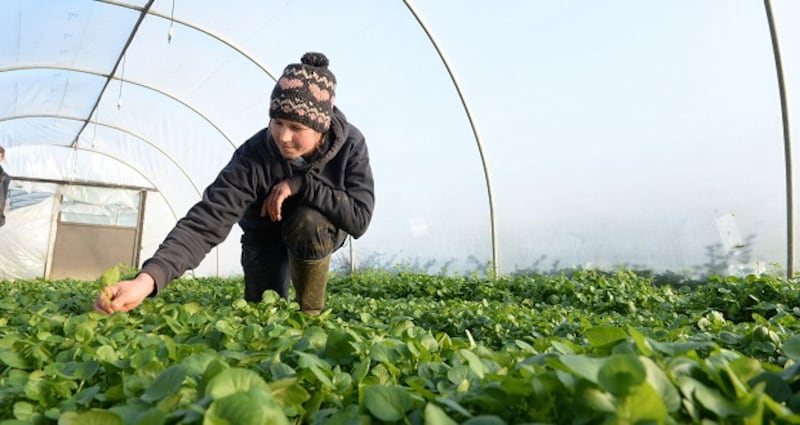
Shifting attitudes
Does all this interest in plant-based diets mean boom-time for Irish vegetable growers? Jenny McNally has watched Irish attitudes to vegetables shift over the last 20 years. She, her husband Pat, daughter Aoife and twin sons Stephen and Patrick run the organic McNally Family Farm in Balrickard, near Balbriggan in north Dublin. Another daughter, Sarah, runs the Market Kitchen, a cafe at the McNally farm stall in Temple Bar and Niamh works in food but not the family business. She’s a manager in Butler’s Pantry.
“People are surprised when we’re not vegetarians. But I say we need the protein for the pure physical work that we do,” she says as we walk past her flock of geese to look at the polytunnels. The geese provide eggs, not meat. They’re refugees from the food chain, she jokes. When they start laying again in January they will have clocked up two Christmas reprieves as the McNallys are just too busy to slaughter them in the run-up to Christmas. Their flock of free-range turkeys that have been growing since July will be the priority for dinner tables.
McNally started growing vegetables on the family tillage and sheep farm over 20 years ago. Fyffes bought her courgette crop for Tesco. “I suddenly realised Tesco were upping their game and they needed these huge big cold stores put up and every grower had to do it. We were tiny. We’d five small children and there was no way we had that sort of money. So we had to bow out there was no way we could take that step at all.”
The first thing McNally says to chefs who want McNally Family Farm veg on their menus is 'we don't deliver'
Her GP mentioned a tiny food market in Temple Bar and McNally went into town (in high heels. She remembers stepping over the cobbles) and set up a stall. She made £70 that day and decided to go down the farmers’ market route. Ninety per cent of their vegetables are sold through their market stalls now and the remaining 10 per cent goes to chefs who are willing to drive down the narrow road to the farm or pick up an order from the market. The first thing McNally says to chefs who want McNally Family Farm veg on their menus is “we don’t deliver”. A lot of the calls end abruptly there and then.
Are vegetables more central to the Irish diet now? “Definitely. Twenty years ago we were growing potatoes, cabbage, the swedes, all the normal standard things like your bacon and cabbage. That’s what people wanted. And that was grand. But as the years have gone on people started asking ‘Have you ever started thinking of trying this?” We bought one small polytunnel and then another. Then in the last five years it’s exploded into all these polytunnels.” (She has lost count of the number).
Tomatoes sweet as jellies
One of them contains a crop of purple persilla, a herb also called shiso in Japanese cookery. Alongside it she is growing lemongrass, not the woody spiky versions grown in Asia but a grassy herb, like the wide rough stems of grass you could turn into a shrieking whistle as a child but tasting deliciously of lemongrass.
Her harvest is a bumper one. Cherry tomatoes sweet as jellies are still on the vines in one tunnel. “We’ve all the usual all the brassicas, all the cauliflowers, the romanescoes, the flower sprouts, kales, Brussels sprout, carrots, parsnips, all the different kinds of beetroot. There’s the pumpkins, which are just amazing this year. Potatoes are unbelievable this year. We’ve had a great growing year, the rain came at the right time and the sun was there at the right time. It’s been one of the best growing years I’ve known in a long time.”
There are certain crops they haven’t mastered. “One is aubergines. I tried again this year and again it was too late. They need respect and time. They need to go in a lot earlier.”
Plant-based eating can be as hands-on or convenience-centred as you want
When I hand back my borrowed wellies and leave, McNally is facing into two days in the quiet of a polytunnel with just the radio for company. She’ll be sowing coriander seedlings in the holes in the weed barrier in between harvesting the potatoes and hand-picking the flower sprouts. It is an astonishingly hands-on farm. One of the chefs she supplies, John Wyer of Forest Avenue, told her the Wednesday email McNally sends out helps in large part to set his menu.
Plant-based eating can be as hands-on or convenience-centred as you want. All going well and McNally is successful with her aubergines next season, cooks can put Balbriggan baba ganoush on their menus. If we are entering the age of veg then those are the dishes I’ll be hunting down.





















